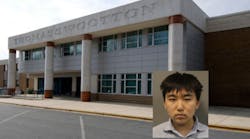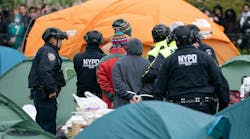Earlier this month, the Maryland Jockey Club announced a new security policy banning backpacks and duffel bags from being brought into Pimlico Race Course for the 138th running of the Preakness Stakes, the second leg of horse racing’s Triple Crown.
Officials said the policy, which will also prohibit laser pointers and cameras with lenses more than 6 inches long, was influenced by last month’s bombings at the Boston Marathon, which killed three people and injured more than 200 others. Only clear coolers will be allowed in the grandstands and infield during the event, which will take place on Saturday.
In addition to these measures, Lt. Samuel Hood III, director of the Baltimore Police Department’s CitiWatch video surveillance network, said that everyone entering the racetrack grounds will also be searched due to the high number of attendees. According to Hood, nearly 120,000 attended last year’s event and this year’s race is expected to draw 150,000.
“We want to make sure everyone has a safe environment and a festive atmosphere for the second jewel of the Triple Crown,” says Hood. “In addition to that, we have just put in more proactive, preventative measures where we will have bomb technicians on scene as vehicles come in and out because of the venue – horses trailers and all of this other equipment – will be checked prior to entering the grounds.”
Hood added that dignitaries, who were chauffeured by retired police officers in previous years, will also be checked before they can enter the venue. Video surveillance will also play a significant role in keeping the event safe for fans as Hood indicated that they have installed cameras in and around the racetrack to monitor the entire infield and grandstand areas.
“These cameras will come back to the CitiWatch platform, so they’re at our level,” says Hood. “They have analytics in them, pre-programmable boards and we record for 28 days so if we have an incident like the Boston bombing, we’re able to in real-time backtrack and identify the origin of the incident. We put in a very comprehensive camera system. We put them in up high, but we also put them in at ground level so we have several dimensions of security that we can see and, of course, at all access points because that way you’re definitely going to see whoever is moving inside the perimeter.”
The surveillance cameras also act as a force multiplier, according to Hood, enabling authorities to quickly determine which incidents require an additional response. “Using real-time situational awareness with the cameras, we’re able to identify what is a call for service and what isn’t a call for service and then what resource (should be used),” Hood added. “You might have a call for service that comes to the police department and it’s actually someone who has had too much sun and they may be having a health situation, so we can send over emergency medical assistance. Working out of one common operating picture, we’re able to get the right resources to the right person in real-time.”
Hood says one of the biggest challenges with securing an event like the Preakness, however, is the size and scope of the venue. “The biggest part is the fact that you have people from all over the world. You have these different horses that come in over several different days you have to check and then you have the barns and you have the parking itself because of the sheer number of individuals,” Hood explained. “Then you have the physical security of electricity, water and even vendors coming in and out, all of that has to be checked.”
Despite the long tradition of the race, Hood said the biggest security incident they’ve had at the Preakness to date is an individual who ran onto the racetrack several years ago. However, Hood said the Maryland Jockey Club has done a phenomenal job of turning the Preakness into an upscale event with numerous live entertainment acts to capture the attention of the crowds. “It has changed,” says Hood. “The event itself has become more of a very festive atmosphere than a party atmosphere.”
Hood said that Baltimore police are working in close cooperation with the Maryland Jockey Club in providing security for the event at their request as they want to ensure that they are doing everything possible to be proactive when it comes to safety. Hood said that the Baltimore Police Department works with a host of partners to keep the race safe including; DHS; FBI; ATF; Maryland State Police; the National Guard; and, the Maryland Transit Administration (MTA). “It’s a whole community approach,” says Hood. “These large-scale events help us prepare for everyday situations.”



